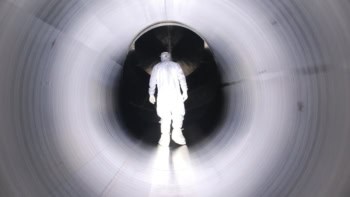
Physicists working on the OPERA experiment in Italy have released preliminary results of a new experiment that appears to confirm their previous finding that neutrinos can travel faster than the speed of light. In September the OPERA collaboration announced that neutrinos travelling 730 km underground from the CERN particle-physics lab in Switzerland to the Gran Sasso lab in Italy appeared to be travelling faster than the speed of light – something that goes against Einstein’s special theory of relativity.
Although some theories allow superluminal speeds for neutrinos, many in the physics community were sceptical of the finding. Shortly after the result was announced, a paper was published in the journal Physical Review Letters that argued that any superluminal neutrinos detected at Gran Sasso should have a distinct energy spectrum as a result of the Cerenkov-like emission of charged particles on the journey – something that was not evident. There also seemed to be some disagreement within the OPERA community about whether the results should be subject to further internal scrutiny before being submitted for publication in a peer-reviewed journal.
Many physicists suspect a systematic error to be the cause of the excess neutrino speed. One issue that was highlighted early on is the effect of the length of the neutrino pulses on the result. In the original experiment the pulses lasted 10.5 µs and were separated by 50 ms, and some critics had suggested that such wide pulses could introduce a systematic error in the time-of-flight measurement.
One neutrino at a time
In this latest experiment the neutrino pulses were shortened to 3 ns long and separated by up to 524 ns. As a result, the experiment is essentially looking at single neutrinos rather than bunches. “With the new type of beam produced by CERN’s accelerators, we’ve been able to measure with accuracy the time of flight of neutrinos one by one,” says Dario Autiero of the Institute of Nuclear Physics of Lyon in France.
This latest experiment involved 20 neutrinos, rather than the 16,000 studied in the previous analysis. However, Autiero claims that the new measurement delivers accuracy that is comparable to the previous work. “In addition, [the] analysis is simpler and less dependent on the measurement of the time structure of the proton pulses and its relation to the neutrinos’ production mechanism,” he says. However, Autiero adds that both results require further scrutiny.
Jenny Thomas of MINOS – a similar neutrino experiment at Fermilab in the US – agrees. “OPERA’s observation of a similar time delay with a different beam structure only indicates no problem with the batch structure of the beam,” she says. “It doesn’t help to understand whether there is a systematic delay that has been over looked.”
The work has been submitted to the arXiv preprint server.



